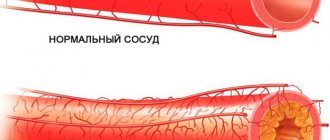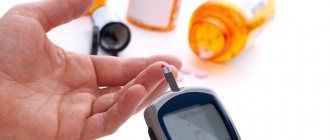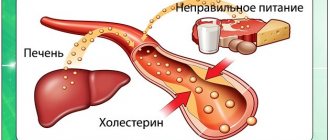Atherosclerosis
Diabetes
Arthritis
Gout
11741 October 14
IMPORTANT!
The information in this section cannot be used for self-diagnosis and self-treatment.
In case of pain or other exacerbation of the disease, diagnostic tests should be prescribed only by the attending physician. To make a diagnosis and properly prescribe treatment, you should contact your doctor. We remind you that independent interpretation of the results is unacceptable; the information below is for reference only.
Cholesterol: indications for use, rules for preparing for the test, interpretation of results and normal indicators.
What is cholesterol
This is a type of lipid present in the structure of human and animal cells. 20% of it comes from food, and the bulk is synthesized by the body itself. At normal concentrations, this substance is not harmful, but even necessary, because it:
- strengthens cell membranes;
- promotes digestion;
- participates in the formation of sex hormones;
- stimulates the production of vitamin D;
- protects nerve fibers;
- reduces cell permeability.
Cholesterol is present in the body at any age. It is required for survival and cannot be replaced by anything. However, we often hear this substance mentioned in a negative context. This is a misconception, since only one type of it causes harm. It is important to distinguish them.
How to prepare for a lipid profile
Anyone can take a lipid profile, but you should prepare for this procedure in advance, otherwise the indicators may be inaccurate. If you are planning to take this test, then ideally you should not drink alcohol for three days or at least a day before going to the clinic.
The night before, refrain from having a heavy dinner with fried, fatty or sweet foods. Try to eat early - no later than 20:00. In the morning - no coffee, tea, mineral water, juice or other sweet drinks - you can only drink plain water.
If you are taking any medications or biologically active substances, check with your doctor whether you can take them before the test, or they may distort the data.
Good and bad cholesterol
In everyday life, good is called high-density lipoprotein, and bad is low-density lipoprotein. Lipoprotein is cholesterol in a protein shell made of apolipoprotein.
High density means that there is little cholesterol in the compound itself: the bulk is protein. In this ratio, lipid transport is facilitated. It enters the liver and is excreted with bile, without settling anywhere. That's why he is considered good.
Low-density lipoprotein, on the other hand, is predominantly composed of cholesterol. Its removal from the body is difficult. This is the type that is considered bad. It lingers in vascular cells and causes atherosclerosis. In addition, it tends to accumulate with age. An adult has much more of it than a child.
Blood cholesterol levels in men and women by age
Over the years, indicators that can be considered normal change. The meanings are not the same for men and women. Here is a table that will help you avoid getting confused and keep your health under control.
| Age | Norm of total cholesterol (mmol/l) | |||
| Women | Men | |||
| Minimum | Maximum | Minimum | Maximum | |
| 20-30 years | 3,16 | 5,75 | 3,16 | 6,32 |
| 30-40 years | 3,37 | 6,27 | 3,57 | 6,99 |
| 40-50 years | 3,81 | 6,86 | 3,91 | 7,15 |
| 50-60 years | 4,20 | 7,77 | 4,09 | 7,15 |
| 60-70 years | 4,45 | 7,85 | 4,12 | 7,10 |
| 71 years and older | 4,48 | 7,25 | 3,73 | 6,86 |
A common myth is that you need to start tracking your cholesterol levels closer to retirement age. This is a big misconception. Doctors recommend donating blood for the first time at the age of 25. The unhealthy lifestyle of modern youth contributes to a more active accumulation of low-density lipoproteins, which is why heart disease increases in age.
When should you start monitoring your cholesterol?
It's never too early for prevention. It’s better to get used to monitoring your health from a young age, then it will present you with fewer unpleasant surprises. It is especially important to pay attention to your health after 40 years of age
, this is true for both men and women. In men, coronary heart disease may begin to develop earlier than in women. This is explained by hormonal levels. Women of childbearing age have more “good” cholesterol in their bodies, while in men the preponderance may lean toward “bad” cholesterol. After menopause, women's bad cholesterol levels may also begin to rise along with their triglyceride levels.
If previously it was believed that atherosclerosis mainly affects mature and elderly people, now the disease is diagnosed in younger patients, so it would be reasonable to start controlling cholesterol levels at 30-35 years of age. If the analysis shows that everything is normal, a re-check can be carried out after 3-4 years, but if the cholesterol level is elevated or there is a genetic predisposition to the development of heart and vascular diseases, then it is worth checking the cholesterol level more often.
Do children suffer from high cholesterol?
Cholesterol levels in children, as a rule, do not rise above normal, but they can also be at risk if hereditary hypercholesterolemia is found in their family. In this case, the child will be registered with a pediatric cardiologist from an early age. A cholesterol test should be done at the age of two years, and then repeated periodically.
Why is lipid metabolism disrupted in the body?
Lipid metabolism is a complex metabolic process. An important part is cholesterol metabolism. Its disorders are one of the main causes of cardiovascular diseases.
The disorder can occur for various reasons:
- heredity (in this case, the first symptoms appear in childhood);
- diseases of the gastrointestinal tract;
- endocrine pathologies;
- lack or excess of enzymes;
- kidney dysfunction;
- taking hormonal medications;
- bad habits;
- increased body mass index;
- physical inactivity.
For an adult, lipid metabolism disorders do not go unnoticed. Men experience hair loss prematurely, and women experience disruptions to their menstrual cycle. Excess cholesterol affects the condition of the skin and general well-being.
New cholesterol controversy
When do you really need to lower cholesterol and who can live long with high levels? The material about this, prepared by KP, was among the top most read on the newspaper’s website.
Dossier "KP"
Philip Kopylov is a professor at the Department of Preventive and Emergency Cardiology, Director of the Institute of Personalized Medicine at Sechenov University, Doctor of Medical Sciences, researcher, cardiologist.
THE MAIN CHALLENGE FOR DOCTORS
Recently, an international group of cardiologists from Sweden, Italy, France, Japan and other countries made a revolutionary statement: there is no evidence to conclusively support the connection between high levels of “bad” cholesterol and cardiovascular disease. The researchers came to this conclusion after studying data from 1.3 million patients. Their health status was monitored for a total of about 50 years. Even more surprising, according to cardiologists, was that older people with high levels of low-density lipoproteins (the same “bad” cholesterol) live on average longer than others! How is this possible? Does this mean that scrambled eggs, butter and fatty meats have been finally rehabilitated, and doctors need to reconsider their approaches to treating heart patients with statin drugs?
“There may be two people standing in front of us, both of them have high cholesterol, only one needs to be treated, and the second can be left alone,” says Philip Kopylov. - Essentially, this is a solution-explanation of the results of a study on the role of cholesterol, which surprised many. The secret is that monitoring people from different risk groups gives different results. And medications act in different ways: if you give them to a sick person according to medical indications, his condition will improve. But if you feed someone who is healthy or who is not so sick that they really need serious medications, then there will be no improvement. The main task, I would even say a challenge, for modern doctors is to determine those who really need to lower cholesterol and when such patients really need statins. Because other people can live longer without treatment, including those with relatively high levels of “bad” cholesterol.
CHECK YOURSELF
What is your risk of cardiovascular disease?
A person is at low risk if they:
a) no high blood pressure. That is, the pressure is not higher than 130/80 mm Hg. Art. under the age of 65 and not higher than 140/80 after 65 years;
b) no excess weight. That is, the body mass index is not higher than 29 (we talked about how to calculate it in the first part of the publication);
c) no diabetes;
d) no atherosclerosis.
- Under such conditions, the patient usually does not need to be treated even if the level of “bad” cholesterol is elevated. That is, if the level of LDL (low-density lipoprotein) in the blood is up to 4.9 mmol/l, explains Philip Kopylov.
If a person is at high risk of cardiovascular disease, including a high risk of heart attack and stroke, then the cholesterol level should be no more than 2.6 mmol/l. And at a very high risk - a maximum of 1.8 mmol/l . If the indicators are higher, they need to be reduced, including with the help of medications.
into the high and very high risk group (depending on the number of risk factors and the degree of neglect) if:
1) is obese. The most dangerous thing is abdominal, that is, in the abdomen. Measure your waist width: for men the critical mark is 102 cm and more, for women – 88 cm and more;
2) high blood pressure (see point “a” above);
3) there is a diagnosis of diabetes mellitus (as a general rule, it is made when the blood sugar level is above 6.7 mmol/l on an empty stomach);
4) the patient abuses salt - exceeds the norm of 5 mg per day, including salt in all dishes and products;
5) overindulges in alcohol. Let us remind you that, according to the latest data, up to 14 servings of alcohol per week for men and up to 8 servings for women are considered relatively safe for health (how much this will be in different types of drinks - see the “Health” section on kp.ru);
6) male gender - the risk of cardiovascular diseases in men is a priori higher;
7) age - for women over 50 - 55 years old; for men - from 45 years old, and if the above factors are present - then starting from 35 years old.
CHOLESTEROL PLAQUE DIFFERENCES PLAQUE
- If I am not in a high or even medium risk group, does this mean that I can unlimitedly eat foods with animal fats - butter, fatty meat, etc.?
— The question is not easy. When we begin to lean on foods rich in animal fats, with a modern sedentary lifestyle, this often results in obesity. You receive at least one risk factor and move from a more “favorable” group to a less favorable one, with a higher risk. And in general, we must admit: the regulation of the system of production and metabolism of cholesterol in the body still partially remains a mystery to scientists. We don't know everything about her.
— Is it undeniable that cholesterol plaques in blood vessels are harmful and dangerous? Or do you also have doubts?
— In humans, already from adolescence, damage to the internal lining of blood vessels begins. And atherosclerotic plaques develop with age in the vast majority of people (essentially, such plaques are accumulations of cholesterol deposits in places of vascular damage. - Author) . However, the problem is that plaques are not all the same. They can be of two types: stable and unstable. And the most serious challenge in cardiology now is to learn to identify and calculate unstable plaques.
- What is their danger?
- At least half of myocardial infarctions occur due to plaques that do not narrow the lumen in the blood vessels or narrow it less than 50%. Such plaques have a thin covering film and a liquid core, where inflammation constantly occurs. Eventually the tire simply breaks. A blood clot forms at this site and blocks the lumen of the vessel. And everything downstream of the blood begins to die.
TO EXERCISE OR NOT TO EXERCISE?
- It is often said that aerobic exercise - brisk walking, running, swimming, ice skating - is useful for increasing blood circulation. And if the plaques are unstable, then it turns out that increased blood flow can worsen the situation?
— Purely theoretically, yes. However, if these loads are regular and reasonable (see below for the “golden” formula for calculating heart rate. - Author) , then they will have a positive effect. Weight and blood pressure will decrease. Also, as a rule, there is a decrease in cholesterol. That is, risk factors are eliminated, and due to this, competent physical exercise brings undeniable benefits. And if you exercise from time to time, and even try to set an Olympic record in the rare moments of your appearance at the gym, then the threat of rupture of plaques and a heart attack really increases significantly.
ON A NOTE
How to determine safe exercise intensity
Use the “golden formula” for calculating your optimal heart rate: 220 minus your age. the resulting figure by 65% - this is the pulse at a moderate load; multiply by 80% - heart rate during intense physical activity. If it is higher, there is already an excessive load, unfavorable for the blood vessels and heart.
QUESTION: WHO NEEDS STATINS?
— Philip Yuryevich, what about statins? Recently, there has been heated debate; the authors of an international study claim that the benefits of such drugs are very doubtful. To whom and why should they be prescribed from your point of view - as a researcher and cardiologist?
- Let's remember: cholesterol enters our body not only with food, 60 - 70% of it is produced in the liver, even if you are on a lean diet. The effect of statins is, on the one hand, to inhibit the production of cholesterol in the liver. At the same time, a mechanism is launched that turns existing unstable plaques into stable ones. And this actually cuts the risk of heart attacks in half.
— It turns out that if a person’s plaques are stable and do not block the lumen of blood vessels, then there are no indications for taking statins? After all, these drugs have serious side effects - from muscle and joint pain to increased blood sugar. When the task is to protect against a real threat, a fatal heart attack, then such “costs” are the lesser of the evils. Are there any current developments to determine the type of plaque in a particular patient?
— There is an intravascular method, when we insert a special sensor into the vessel and use ultrasound or optical coherence tomography to determine the structure of the plaque.
- Do you need to check every plaque?
- Yes. And the sensor, unfortunately, is expensive. Another approach is computed tomography. We put the patient in a computer scanner and do an X-ray examination with contrast of the heart vessels. The resolution of computed tomographs today makes it possible to determine what kind of plaque it is - stable or unstable.
The third approach is a blood test. Now it is actively developing. Very interesting research work is being carried out on microRNAs, that is, small molecules that are responsible for inflammation and the development of atherosclerosis. Based on their presence, concentration and combination, they are trying to build diagnostic systems to identify unstable plaques.
— Are any of these methods used in Russia?
- So far - on a minimal scale, only in large cardio centers, and then as research work for the most part. In general, the problem of determining the type of plaques is solved in different ways throughout the world. The latest international recommendations propose the introduction of computed tomography with contrast as a method of primary diagnosis.
CONGRATULATIONS!
“Sechenovka” has an anniversary!
In 2021, Sechenov University, First Honey, the legendary “Sechenovka”, as it is often called among the people, turns 260 years old. Over these centuries, they worked, taught, treated, created breakthrough methods for saving people here, and most Russian medical luminaries continue to do so. Among the stars of the university is the founder of the school of military field medicine, Nikolai Pirogov ; famous surgeon, professor Nikolai Sklifosofsky ; the founder of Russian forensic psychiatry Vladimir Serbsky ; founder of the medical examination system Nikolai Semashko ; founder of neurosurgery Nikolai Burdenko; founder of the school of cardiovascular surgery Alexander Bakulev . Now among the professors at Sechenovka are academician Leo Bockeria , the chief transplantologist of the Russian Ministry of Health, academician Sergei Gauthier , one of the leading Russian oncological surgeons, an expert on head and neck tumors, academician Igor Reshetov , and many others.
«
Komsomolskaya Pravda" congratulates Sechenov University and wishes new scientific and medical breakthroughs!
Link to publication:
Symptoms of high cholesterol in the body
An excess of this substance has external signs. White circles form around the iris of the eye. The skin turns yellow and lipid deposits (xanthomas) appear on it. Usually these are small tubercles, but there are xanthomas in the form of papules.
The remaining symptoms do not specifically indicate increased cholesterol. The patient experiences:
- pain in the legs when walking;
- feeling of chest compression;
- heartache;
- digestive disorders.
All these troubles suggest that it’s time to see a doctor. It is difficult to understand from the symptoms that it is time to take an LDL test. As a result, lipid metabolism disorders go unnoticed for a long time, sometimes until the vessel becomes blocked. Because of this, cholesterol is called the silent killer.
Symptoms of diabetes in women
Oddly enough, women are more likely to suffer from this disease. The opinion that the female sex is more predisposed to eating sweets is erroneous. What is the real reason for the development of diabetes in women? The body of women is structured differently, the endocrine system is no exception; it experiences hormonal changes during a woman’s pregnancy or during menopause, hence disturbances in insulin production are observed.
The first prerequisites for diabetes mellitus in women are:
- Thirst due to dry mouth.
- Sudden weight gain.
- Sudden weight loss (for no reason).
- Frequent urination (especially at night).
- Decreased performance, rapid fatigue.
- Dryness and itching of the skin.
- The appearance of age spots on the body and face.
- Deterioration of vision.
- Memory problems.
- Changes in the menstrual cycle.
What to do to normalize cholesterol
Today it is not uncommon for the results of a blood test for total cholesterol to deviate from normal. At the same time, there may be a lack of good things in the body, while the level of bad things is increased. Accordingly, the value of low-density lipoproteins should be reduced, and high-density lipoproteins should be increased.
Let's start with the last one. Intense physical activity is enough for this. Clearing the body of LDL is more difficult. It requires:
If high cholesterol is caused by an endocrine or other disease, it will be difficult to lower it without proper treatment. Therefore, before taking measures, it is worthwhile to undergo a comprehensive examination, in particular, donate blood for hormones.
Measuring sugar levels with a glucometer
This method is the fastest and most convenient. For more accurate indicators, the following tips should be followed:
- Read the instructions carefully.
- It is recommended to perform a blood test on an empty stomach (on an empty stomach).
- Wash your hands with soap and rub your finger to warm it up.
- Wipe your finger with an alcohol solution.
- Prick your finger on the side with a piercing pen.
- Take a second drop of blood onto the test strip: the first is removed with cotton wool.
- After two seconds, the test result will appear on the meter screen.
To ensure accurate results, follow the specialist’s recommendations before taking the test.
Diet and lifestyle of people with high cholesterol
An adult understands that a normal cholesterol level is the key to vascular health. Atherosclerosis impedes blood flow, forcing the heart to work harder to pump blood through the narrowed arteries. Sooner or later the plaques will block the vessel, and the person will have a heart attack.
To avoid this outcome, it is important to achieve normal LDL levels. To do this, it is important to adjust your lifestyle, and first of all, your eating habits:
- reduce consumption of trans fats;
- increase your intake of monounsaturated fats;
- increase consumption of polyunsaturated fats;
- give up instant coffee and drink only natural coffee in limited quantities.
We must not forget that the level of cholesterol in the blood changes over the years. Therefore, you need to review your diet periodically (at least once every five years). And it is better to do this under the supervision of a doctor.
Fluctuations in glucose levels
Hyperglycemia (increase)
The patient may have either a short-term increase in blood sugar concentration or a permanent one. Increased levels on an empty stomach - more than 5.5 mmol/l, after a meal - more than 7.8 mmol/l. Hyperglycemia is divided into 4 forms:
- chronic hyperglycemia. It can be mild (6–10 mmol/l), moderate (10–16 mmol/l) and severe (more than 16 mmol/l). Occurs exclusively in patients with diabetes. Due to poor pancreatic function, the body produces insufficient amounts of insulin. And also this pathology is transmitted hereditarily.
- nutritional hyperglycemia. After eating, blood glucose levels increase, especially in the first few hours. This form of hyperglycemia does not require treatment, because glucose levels return to normal on their own after a certain period of time.
- emotional hyperglycemia. This form occurs after a stressful condition. Having excited the nervous system, the body begins to produce thyroid hormones. With a high content of them in the blood, the body stops producing glycogenesis, but the production of gluconeogenesis and glycogenolysis increases. For these reasons, blood sugar increases.
- hormonal hyperglycemia. It appears due to a surge of certain hormones in the blood, such as glucocorticoids, glucagon, catecholamines and thyroid hormones.
Symptoms of hyperglycemia:
- frequent urination;
- itching of the skin;
- hunger;
- strong thirst;
- blurred vision;
- drowsiness, lethargy;
- nausea.
Treatment is prescribed only if the development of hyperglycemia is detected.
During hypoglycemia, a diabetic needs to have something sweet on hand, as sugar can drop sharply
Hypoglycemia (sharp decrease)
Indicators are less than 3.3 mmol/l.
Main causes:
Symptoms of type 2 diabetes in women
- incorrect insulin dose;
- untimely consumption of food (missing more than 6 hours);
- insufficient amount of carbohydrates in the diet;
- unplanned or intense physical activity;
- alcohol abuse;
- drug use;
- non-compliance with the diet or an incorrectly formulated diet.
Symptoms of hypoglycemia:
- shiver;
- increased sweating;
- state of pathological fear;
- dizziness, fainting;
- hunger;
- increased heart rate;
- weakened vision;
- weakness, drowsiness, apathy;
- headache;
- increased irritability.
If there is a sudden decrease in blood glucose, the patient needs to eat something sweet, such as candy, honey, or drink tea with sugar.
IMPORTANT! In both cases, it is necessary to bring blood sugar to a normal level, since jumps in both directions lead to disturbances in the body’s metabolism.
The level of glucose in the blood directly depends on the age of the woman. Statistics show that deviations from the norm in most cases are observed in women after 40 years of age.
What you can’t eat and what you can
The difficulty in following the diet is that banned trans fats are found in foods that many are accustomed to. The patient will have to completely give up sweets and starchy foods and reduce the consumption of fatty foods to a minimum. Nutritionists are trying to find healthy alternatives to unhealthy foods.
| It is forbidden | Can |
| Cakes | Oat cookies |
| Pork | Chicken |
| Fried foods | Stews |
| Butter | Vegetable oil |
| Sour cream | Low-fat yogurt |
| By-products (liver, lungs) | Fish |
| Semolina | Oatmeal |
| Marmalade | Natural jelly |
Eggs are a controversial product. Yolks help increase cholesterol, while proteins, on the contrary, are useful for its breakdown. The recommended solution is to divide the egg into parts and eat only the whites.
Ways to Maintain Normal Cholesterol Levels
High levels are recorded in a biochemical blood test. If the numbers regularly exceed the norm, it is important to undergo a medical examination of the thyroid, pancreas, liver, and take a hormonal profile test. To normalize fat metabolism, courses of antilipid drugs are prescribed.
A therapeutic diet low in meat and dairy products also helps lower total cholesterol. It is useful to include sea fish containing Omega-3 complex, olive, flaxseed, sunflower oils, fresh vegetables, and herbs in your food.
Drugs that lower total cholesterol
This group of medications is called stanina. This is one of the types of lipid-lowering drugs used to eliminate lipid metabolism disorders.
Statins are used when the level of low-density lipoprotein is so high that it is impossible to reduce it with lifestyle changes. You cannot take them without permission, since the wrong dosage will affect the functioning of the liver. It is better for an adult to make an appointment with a cardiologist.
Vitamins also help indirectly with high cholesterol. The main role here is given to representatives of group B. B3 is involved in fat metabolism, B6 promotes the absorption of fatty acids, B8 accelerates lipid metabolism. Vitamins A and E prevent the formation of cholesterol plaques.
THERE ARE CONTRAINDICATIONS, BEFORE USE YOU MUST CONSULT WITH A SPECIALIST
Treatment
Along with treatment of the underlying disease, the following measures are taken to reduce cholesterol levels:
- normalization of physical activity (their degree depends on the level of oxygen flow);
- diet aimed at weight loss;
- balanced nutrition with control of substances entering the body;
- giving up bad habits and foods that contain cholesterol.
During drug therapy, the patient takes medications to cleanse the blood and correct the cellular structure (drugs that contain omega-3 PUFAs, HMG-CoA reductase inhibitors, lipid-lowering agents, fibrates, etc.).










